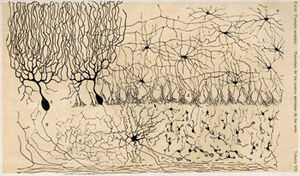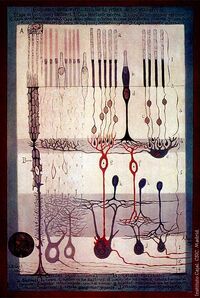
Ramón y Cajal's drawing of the cells of the chick cerebellum, from "Estructura de los centros nerviosos de las aves", Madrid, 1905.
The neuron doctrine is the now fundamental idea that neurons are the basic structural and functional units of the nervous system. The theory was put forward by Santiago Ramón y Cajal in the late 19th century. It held that neurons are discrete cells (not connected in a meshwork); that neurons are genetically and metabolically distinct units; that they have cell bodies, axons, and dendrites; and that neural transmission goes only in one direction, from dendrites toward axons (Sabbatini).
History[]
Before the neuron doctrine was accepted, it was widely believed that the nervous system was a reticulum, or a connected meshwork, rather than a system made up of discrete cells (Kandel et al., 2000). This theory, the reticular theory, held that neurons' somata mainly provided nourishment for the system (DeFelipe, 1998). Even after the cell theory was postulated in the 1830s, most scientists did not believe the theory applied to the brain or nerves.

Drawing by Ramón y Cajal from "Structure of the Mammalian Retina" Madrid, 1900.
The initial failure to accept the doctrine was due in part to inadequate ability to visualize cells using microscopes, which were not developed enough to provide clear pictures of nerves. With the cell staining techniques of the day, a slice of neural tissue appeared under a microscope as a complex web and individual cells were difficult to make out. Since neurons have a large number of neural processes an individual cell can be quite long and complex, and it can be difficult to find an individual cell when it is closely associated with many other cells. Thus, a major breakthrough for the neuron doctrine occurred in the late 1800s when Ramón y Cajal used a technique developed by Camillo Golgi to visualize neurons. The staining technique, which uses a silver solution, only stains one in about a hundred cells, effectively isolating the cell visually and showing that cells are separate and do not form a continuous web. Further, the cells that are stained are not stained partially, but rather all their processes are stained as well. Ramón y Cajal altered the staining technique and used it samples from younger, less myelinated brains, because the technique did not work on myelinated cells (Sabbatini). He was able to see neurons clearly and produce drawings like the one at right.
For their technique and discovery respectively, Golgi and Ramón y Cajal shared the 1906 Nobel Prize in Physiology or Medicine. Golgi could not tell for certain that neurons were not connected, and in his acceptance speech he defended the reticular theory. Ramón y Cajal, in his speech, contradicted that of Golgi and defended the now accepted neuron doctrine.
A paper written in 1891 by Wilhelm von Waldeyer, a supporter of Ramón y Cajal, debunked the reticular theory and outlined the Neuron Doctrine.
Challenges to the neuron doctrine[]
While the neuron doctrine has remained a central tenet of modern neuroscience, recent studies challenging this view have suggested that the narrow confines of this doctrine need to be expanded. Among the most serious challenges to the neuron doctrine is the fact that electrical synapses are more common in the central nervous system than previously thought. This means that rather than functioning as individual units, in some parts of the brain large ensembles of neurons may be active together in order to process neural information. A second challenge comes from the fact that dendrites, like axons, also have voltage gated ion channels and can generate electrical potentials which convey information to and from the soma. This challenges the view that dendrites are simply passive recipients of information and axons the sole transmitters. It also suggests that the neuron is not simply active as a single element, but that complex computations can occurr within a single neuron. Finally, the role of glia in processing neural information has begun to be appreciated more. Neurons and glia make up the two chief cell types of the central nervous system. There are far more glial cells than neurons, it has been estimated that glial cells outnumber neurons by as many as 50:1. Recent experimental results have suggested that glial cells play a vital role in information processing among neurons, indicating that neurons may not be the sole information processing cells in the nervous system.
Assessment |
Biopsychology |
Comparative |
Cognitive |
Developmental |
Language |
Individual differences |
Personality |
Philosophy |
Social |
Methods |
Statistics |
Clinical |
Educational |
Industrial |
Professional items |
World psychology |
Biological: Behavioural genetics · Evolutionary psychology · Neuroanatomy · Neurochemistry · Neuroendocrinology · Neuroscience · Psychoneuroimmunology · Physiological Psychology · Psychopharmacology (Index, Outline)
References[]
- DeFelipe J. 1998. Cajal. MIT Encyclopedia of the Cognitive Sciences, MIT Press, Cambridge, Mass.
- Kandel E.R., Schwartz, J.H., Jessell, T.M. 2000. Principles of Neural Science, 4th ed., p.23. McGraw-Hill, New York.
- Sabbatini R.M.E. Neurons and Synapses: The History of Its Discovery.
- Bullock, T.H., Bennett, M.V.L., Johnston, D., Josephson, R., Marder, E., Fields R.D. 2005. The Neuron Doctrine, Redux, Science, V.310, p. 791-793.
External links[]
| This page uses Creative Commons Licensed content from Wikipedia (view authors). |